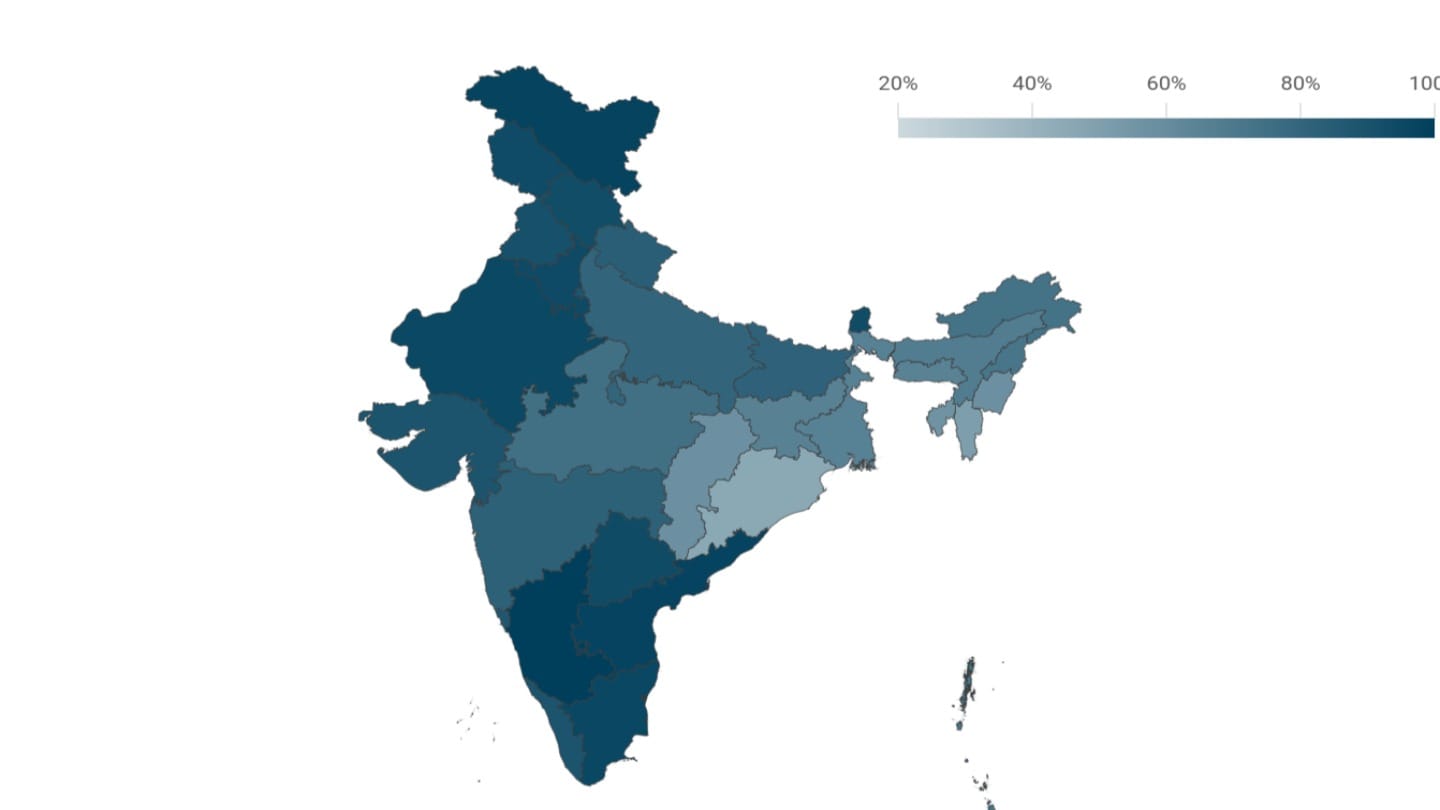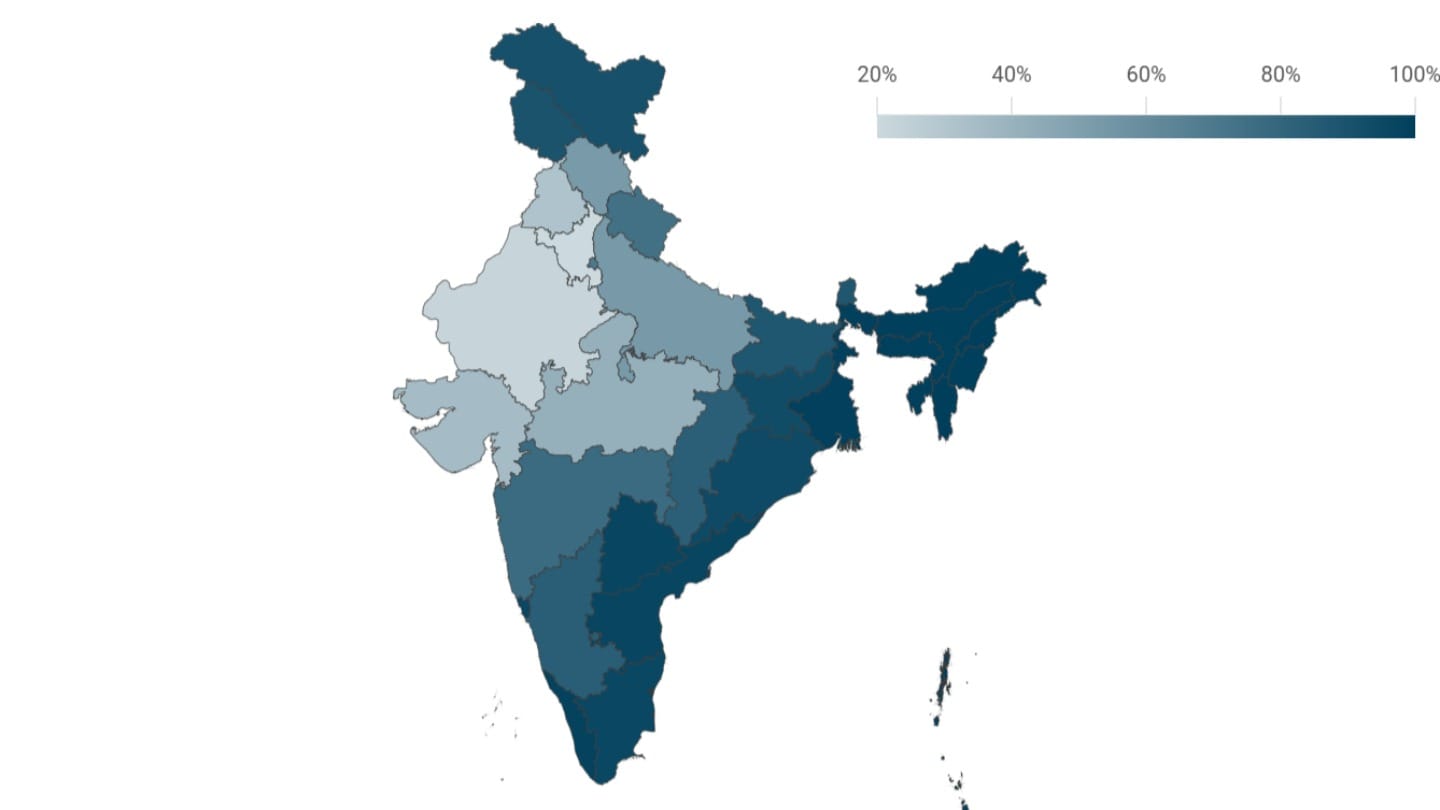Infant mortality in India
The number of children who do not survive until their first birthdays has fallen dramatically. Yet parts of the country have relatively high Infant Mortality Rates, and the first week of a child's life remains a time of high risk.
Infant mortality, or the death of a child before his or her first birthday, is a key measure of public health. A child's survival in the first year reflects the social, economic, and environmental conditions in which he or she is born, including access to healthcare, nutrition, and sanitation.[1]
Nearly 638,000 infants under the age of one died in India in 2023.[2] This amounted to more than one infant death every minute.
However, India has seen major progress over the last few decades. The number of infant deaths in 2001 was almost three times higher, at 1.7 million. Infant mortality - deaths proportionate to live births - in India has fallen faster than the global average but slower than in our neighbouring country, Bangladesh.[3]
How many infants die before the age of one?
The Infant Mortality Rate (IMR) is defined as the number of deaths of children under the age one for every 1,000 live births in a given year.[4] Infant mortality data comes from the Sample Registration System (SRS), a large-scale sample survey conducted by the Registrar General of India. The SRS is designed to track births and deaths at the local level across the country. The latest SRS statistical report is based on data from about 162,000 live births.[5]
India's IMR in 2023 was 25 deaths for every 1,000 live births.
There remains a significant rural-urban gap, with rural IMR at 28, compared to 18 in urban areas as of 2023. However there has been rapid progress in India in lowering infant deaths in both rural and urban India.
In 1981, the IMR was 110 infant deaths for every 1,000 live births. Over the last four decades, the IMR has fallen to a quarter of its 1981 level. In just the last 15 years, the IMR has nearly halved in both rural and urban India.
When are infants at greatest risk?
Infancy is one of the most vulnerable periods of an individual's life; seven out of every 100 deaths in the country are of infants under the age of one.
Within infancy, it is the first week that is the most precarious. Over half of all infant deaths occur in the first week after birth, or in the early neonatal period.
While both neonatal (within the first month) and post-neonatal (from the infant's second month to the end of the first year) mortality have declined, the decline in mortality rates after the child's first month has been sharper. The share of deaths within the first month has increased from 61% in 2003 to 73% in 2023, meaning that infant deaths are fewer, but are increasingly concentrated in the earliest days of life.
Reducing neonatal deaths is critical to lowering infant mortality overall. India's Sustainable Development Goals target is to reduce neonatal mortality to 12 per 1,000 live births by 2030, as against its 2023 neonatal mortality rate of 19.[6]
Who is most affected?
Infant deaths are more common among poorer households. The gap within urban areas is especially stark, with infant deaths over three times as frequent in the poorest group of households than among the richest. While rural areas have higher infant mortality overall, the poorest section of urban India experiences the highest IMR.[7]
At the state level, southern states, with richer economies and better access to healthcare and education for women, have lower infant mortality rates. Kerala has the lowest IMR at 5, followed by Tamil Nadu at 12. Kerala's IMR is comparable to high-income countries and even slightly below that of the United States of America.[8]
The relatively poorer states of Uttar Pradesh, Madhya Pradesh, and Chhattisgarh record the highest IMR at 37, similar to that of Sudan. Over half of all infant deaths in India occur in Uttar Pradesh, Bihar, and Madhya Pradesh, with Uttar Pradesh alone accounting for one in three.
While most states and UTs have recorded decline in infant mortality, there have been some recent increases. Since 2020, increases have been observed in Jharkhand, Delhi, Punjab, Maharashtra, Haryana, Jammu & Kashmir and Tamil Nadu.
Causes of infant deaths
Among newborns who die within the first month, the leading causes are complications from preterm birth, birth asphyxia, and infections such as sepsis or lower respiratory infections.[9] Together, these account for nearly 8 in 10 neonatal deaths, with preterm birth complications alone responsible for about a third.
Preterm birth is associated with factors like the age of the mother at the time of birth, short birth intervals and poor access to antenatal care.[10] Although 94% of women received some antenatal care during pregnancy, two in five did not receive the recommended minimum of four ANC checkups as recommended by the WHO.[11]
For infants aged one month to one year, the main causes are lower respiratory infections, diarrhoea, and congenital heart anomalies. Infectious diseases are a significant cause of death. Deaths from injuries make up a smaller share overall, but they have been rising in recent years.[12]
The cause of infant mortality varies across states. Preterm birth and other neonatal disorders are the leading causes across regions. In states with lower IMR, such as Tamil Nadu and Kerala, the share of deaths from infectious diseases is smaller. In northern and northeastern states with higher IMR like Uttar Pradesh, Mizoram and Bihar, infections account for over one-third of all infant deaths, while in the southern states they make up less than one-fourth.
[1] World Health Organisation.
[2] We calculate the absolute number of infant deaths by using an Infant Mortality Rate of 25 from the Sample Registration System, and the absolute number of live births in 2023 by applying the Crude Birth Rate from the SRS Statistical Report to an estimated 25.5 million live births in 2023 from the Census Population Projections.
[3] World Bank World Development Indicators.
[4] World Health Organisation. Live births refers to deliveries where a baby is born alive, irrespective of the duration of pregnancy of the mother.
[5] The SRS statistical report in 2023 covered a population of about 8.8 million people. With a crude birth rate of 18.4, the total live births can be estimated to come to about 161,920.
[7] National Family Health Survey 2019-21. According to the NFHS, India's IMR was 35 in 2019-21. The NFHS estimates IMR using data on live births and infant deaths that occurred during the five-year preceding the survey, rather than for a single reference year. The NFHS estimate is higher than the SRS estimate for similar years.
[8] World Bank World Development Indicators.
[9] The Institute for Health Metrics and Evaluation's Global Burden of Disease (GBD).
[10] Risk factors for preterm birth and its effect on neonatal mortality in India: evidence from the National Health Family Survey-5 (2025), Dixit, Bhatia, et al, Discover Public Health
[11] National Family Health Survey 2019-21.
[12] National, regional & state-level cause-specific U5 mortality 2000-15 (2019), Liu, Li et al, Lancet Global Health.




